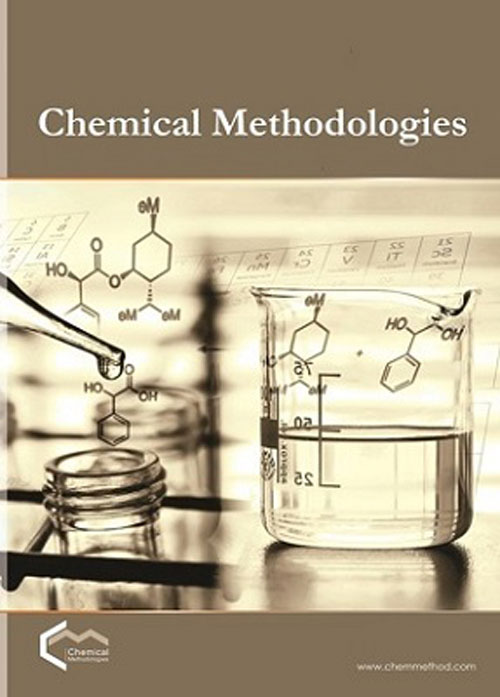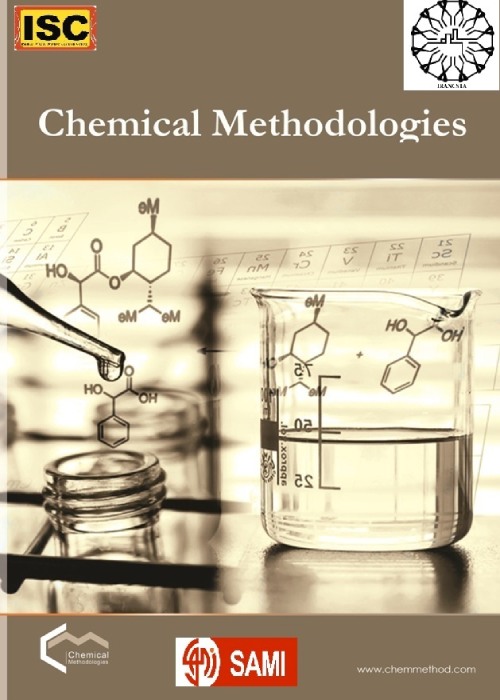فهرست مطالب

Chemical Methodologies
Volume:6 Issue: 4, Apr 2022
- تاریخ انتشار: 1401/01/03
- تعداد عناوین: 8
-
-
Pages 269-279In this research study, the synthesis sequence of novel pyridazine and 1,2,4-Triazine derivatives was determined by reacting α-hydrazino-N-Carbazole acetamide (1) with acid anhydride derivatives used glacial acetic acid as a solvent to prepare compounds (2-9) pyridazine derivatives reacted compound (1) with phenyl isocyanate, phenyl thioisocyanate, and α-naphthyl isocyanate to use absolute ethanol as solvent to give compounds (10-12). Compounds (10-12) were condensed with (2N. NaOH) to give compounds (14-16) to denominate 1,2,4-Triazine derivatives. Reacted compound (1) with CS2/KOH used absolute ethanol as solvent to provide potassium salt (13). This salt reacts with 95% hydrazine hydrate to give compound (17). The newly synthesized compounds were tested against different microorganisms to evaluate their antimicrobial activities on bacterial strains, gram-positive bacteria, gram-negative bacteria, and fungal strains to identify the most efficient biologically active compounds.Keywords: Carbazole, Pyridazine, 1, 2, 4-Triazine, anti-microbial
-
Pages 280-292
Microwave energy is non-ionizing radiation that causes the molecule to move and is a good way to extract compounds from plant extracts. This study aimed to investigate the effect of three independent variables including solvent type (water and methanol 80%), time (3, 6, and 9 minutes), and microwave power (100, 200, and 300 watts) on the flavonoids, anthocyanins, antioxidant properties (IC50) of the Persian Golnar plant or Punica granatum var. pleniflora (PGP) extract. According to results, simultaneous optimization of extraction conditions with 95.609% desirability in 300-watt microwave power, 9 minutes, and use of methanol solvent the flavonoid content was 5.7597 mg /g, anthocyanin content was 4.7983 µmol/g, and IC50 value was 6.5063 mg/ml. The highest average of minimum inhibitory concentration and minimum Bactericidal concentration of PGP extract were 1250 and 5000 µg/ml, respectively against Clostridium perfringens and Escherichia coli, and the better antimicrobial effect was against Staphylococcus aureus with the highest diameter of zone of inhibition (11 mm) compared to Escherichia and Clostridium perfringens. According to the results of this study, microwave pretreatment with optimized conditions can be used to extract significant amounts of phenolic and antimicrobial compounds of PGP extract as a rich source of antioxidants with minimal damage to its effective compounds.
Keywords: Anthocyanin, Antioxidant, Flavonoid, Microwave, Punica granatum var. pleniflora -
Pages 293-300In this work, nanolayered Ti3C2 was applied to construct a modified screen printed electrode (SPE). This modified electrode (Ti3C2/SPE) was applied for detecting tyrosine with various voltammetric procedures. Modifying the working electrode increased electro-oxidation of tyrosine as the current intensity enhanced. Moreover, Ti3C2/SPE was employed for determining tyrosine in concentration ranges from 0.5-700.0 μM with the low LOD of 0.15 μM using DPV.Keywords: Nanolayered Ti3C2, modified screen printed electrode, Tyrosine, Differential pulse voltammetry
-
Pages 301-318The microemulsion approach was used to create three new nano nanocomposites: Lead oxide (LO)/PbO, lead iron oxide (LIO)/PbO-Fe2O3 and lead iron oxide polypyrrole (LIOPYY)/PbO-Fe2O3-polypyrrole. X-ray diffraction (XRD), Raman, field emission scanning electron microscopy (FESEM), Brunauer–Emmett–Teller (BET) surface area, vibrating-sample magnetometer (VSM), and thermal gravimetric analysis were used to describe the nanocomposites (TGA). LO and LIO composites have an orthorhombic crystal structure, whereas LIOPYY nanocomposites have a monoclinic crystal structure, according to XRD studies. The Scherrer equation was used to calculate the crystallite size, which was a high value in LO and a low value in LIOPYY. A considerable shift in the composite structure was discovered using Raman analysis, confirming the formation of nanomaterials. The AC conductivity measurements revealed that LO has a lower conductivity than LIO, whereas LIOPYY has a greater conductivity. LIO exhibits higher Ms Values when measured using the VSM method.Keywords: lead oxide, Microemulsion, Iron oxide, Polypyrrole
-
Pages 319-330
A new methodology was applied to the synthesis of new imidazolones and oxyazepine derivatives containing imidazo thiazole fused rings. Starting with 5-(4-bromo phenyl) imidazo (2, 1-b) thiazole, which was synthesized using the standard procedure, the Carbaldehyed group was introduced at position 6 of 5-(4-bromo phenyl) imidazo (2, 1-b) thiazole. Then, this 6-carbaldehyed derivative was condensed with different substituted aromatic amines to afford new Schiff bases. The latter were cyclized into new oxazepine and imidazolone derivatives by using phthalic anhydride and glycine, respectively. These new derivatives were characterized by using FT-IR, 1HHNMR, and 13CNMR spectra, as well as examined (evaluated) for anti-bacterial and anti-fungal activities.
Keywords: Imidazo thiazole, oxazolones, imidazolidone, Aantimicrobial -
Pages 331-338Iraqi calcium bentonite was activated via acidification to study its structural and electrical properties. The elemental analysis of treated bentonite was determined by using X-ray fluorescence while the unit crystal structure was studied through X-ray diffraction showing disappearance of some fundamental reflections due to the treatment processes. The surface morphology, on the other hand, was studied thoroughly by Scanning Electron microscopy SEM and Atomic Force Microscope AFM showing some fragments of montmorillonite sheets. Furthermore, the electrical properties of bentonite were studied including: The dielectric permittivity, conductivity, tangent loss factor, and impedance with range of frequency (0.1-1000 KHz) at different temperatures.Keywords: Bentonite, Dielectric Constant, conductivity, Impedance, Permittivity, tangent loss factor
-
Pages 339-346A series of novel pyrazol-4-yl- dihydro-1H-inden-1-one derivatives were synthesized by using greener catalyst pH 12.5 (Bleaching earth clay BEC) as an efficient catalytic and PEG-400 as a green, recyclable solvent. All the synthesized compounds are characterized with 1HNMR, 13CNMR, IR and Mass Spectroscopy techniques. The synthesized molecules are subjected for the molecular docking study with 6KZV-A enzyme, the compounds IIb (E)-2-((1-(4-bromophenyl)-3-phenyl-1H-pyrazol-4-yl)methylene)-2,3-dihydro-1H-inden-1-one, IIc(E)-2-((3-phenyl-1-(p-tolyl)-1H-pyrazol-4-yl)methylene)-2,3-dihydro-1H-inden-1-one, IId (E)-2-((1-(4-methoxyphenyl)-3-phenyl-1H-pyrazol-4-yl)methylene)-2,3-dihydro-1H-inden-1-one and IIe (E)-2-((1-(4- nitrophenyl)-3-phenyl-1H-pyrazol-4-yl)methylene)-2,3-dihydro-1H-inden-1-one shows the desired bonding interaction with 6KZV-A enzyme. The compounds further were evaluated for antimicrobial activities. Amongst these synthesized compounds, the mentioned compounds show good to moderate antimicrobial activities.Keywords: Molecular docking, Antimicrobial, Bleaching earth clay pH 12.5, PEG-400 α, β -unsaturated ketones
-
Pages 347-356In this work, natural polymer Gelatin grafting was carried out with succinic anhydride by ring-opening polymerization then complexion with (Cr+3), (Mn+2), (Ni+2), and (Zn+2) was synthesized. The structure was characterized using FT-IR and UV-Vis. The results revealed that the structures of these complexes are Octahedral. The spectroscopic result of the ligand showed a bidentate behavior through the coordination via oxygen and nitrogen atoms. The newly synthesized polymers were tested as corrosion inhibitors on carbon steel alloy. The results of corrosion test indicated the corrosion decrease by using the new polymers on the service of the alloy. Inorganic polymers are appealing metals and alloys as corrosion inhibitors in various applications as they are cost-effective, renewable materials that are readily accessible, non-hazardous, possibly biodegradable, and biocompatible with the natural environment.Keywords: Gelatin, Succinic anhydride, carbon steel, Metal complexes, corrosion


